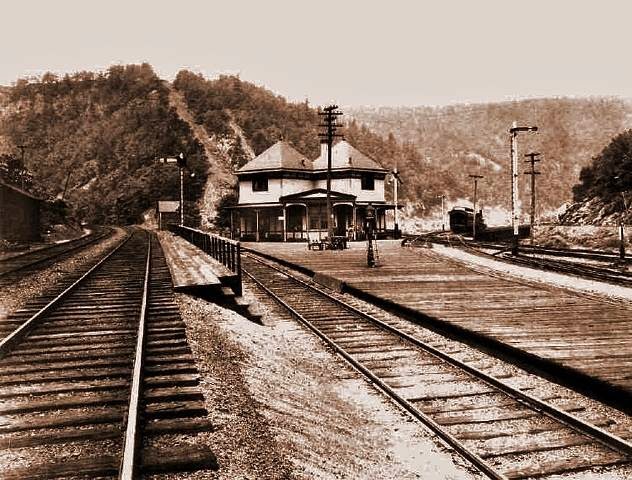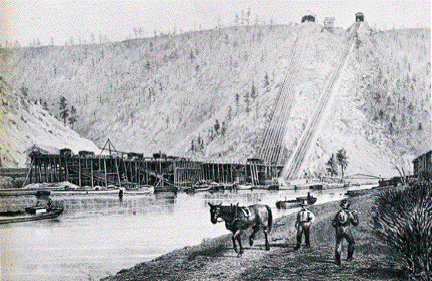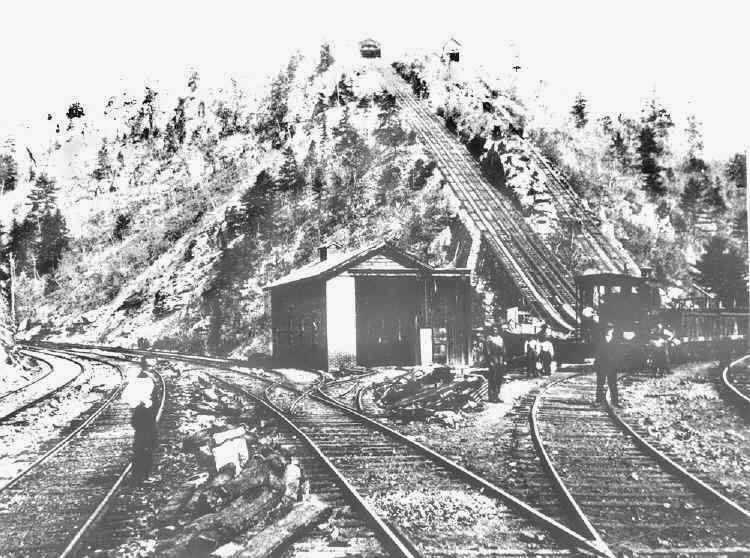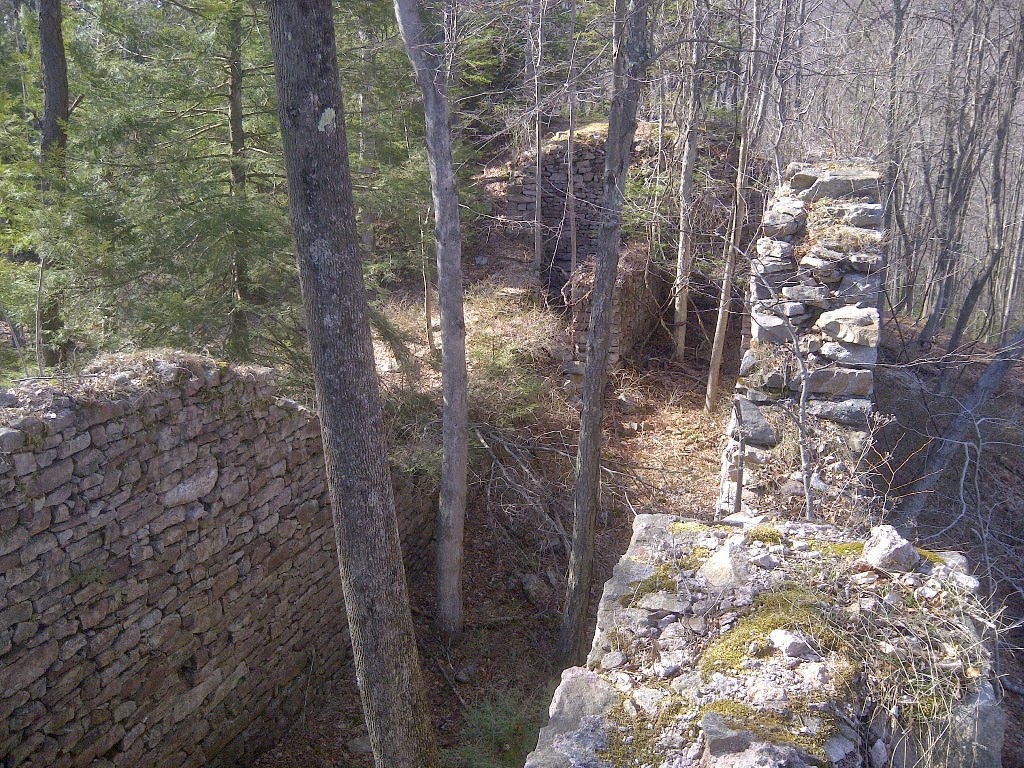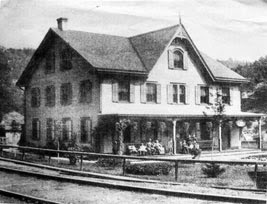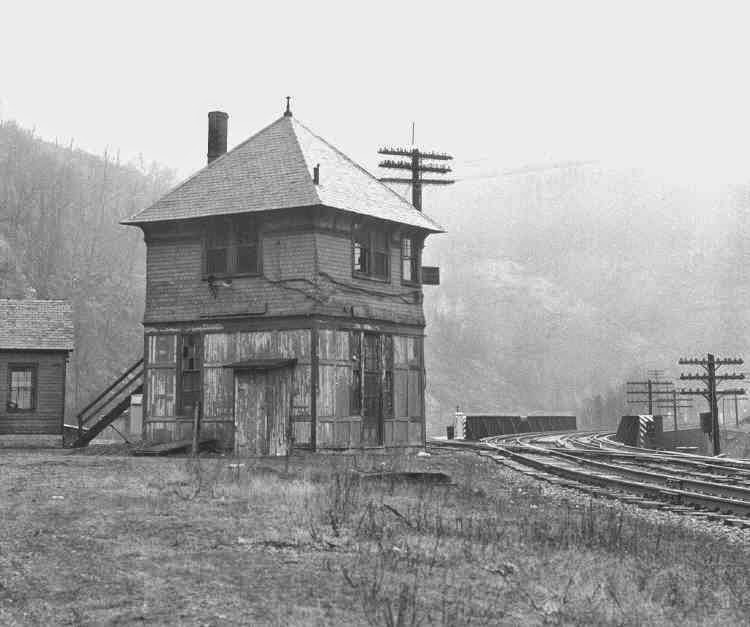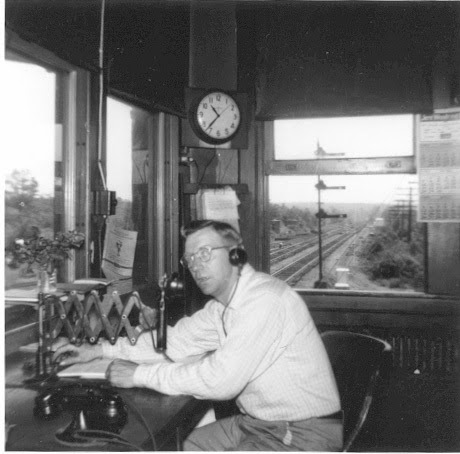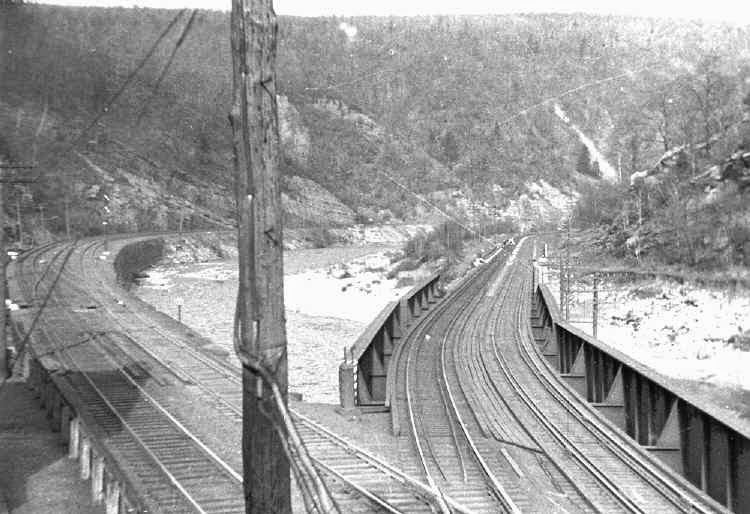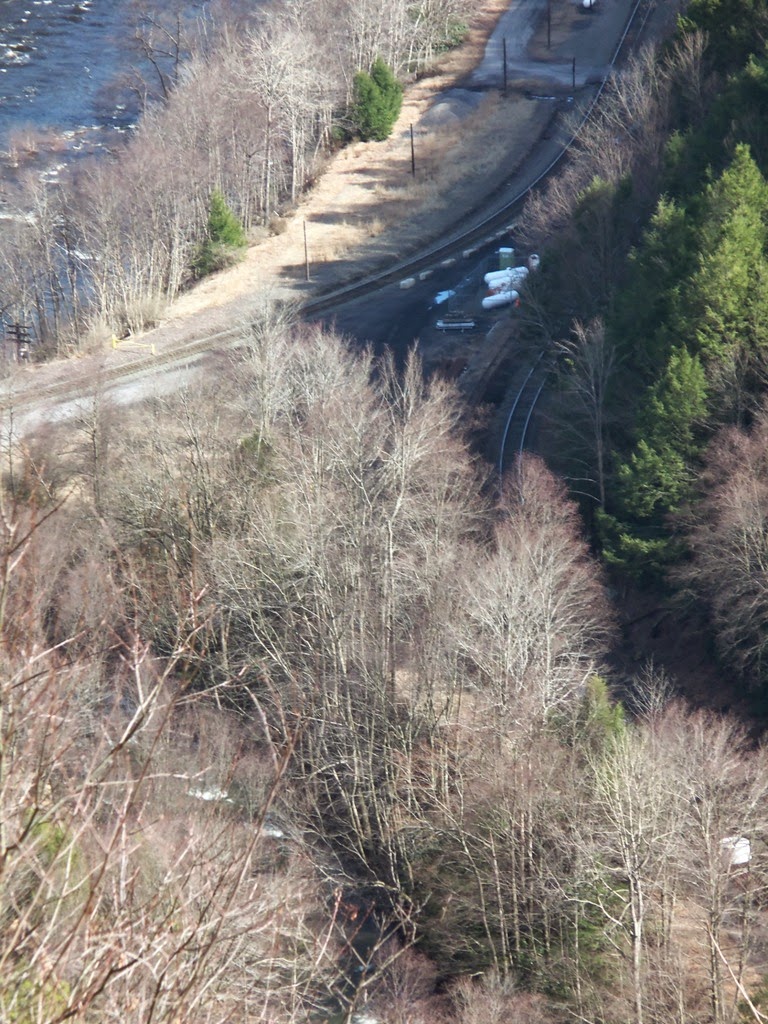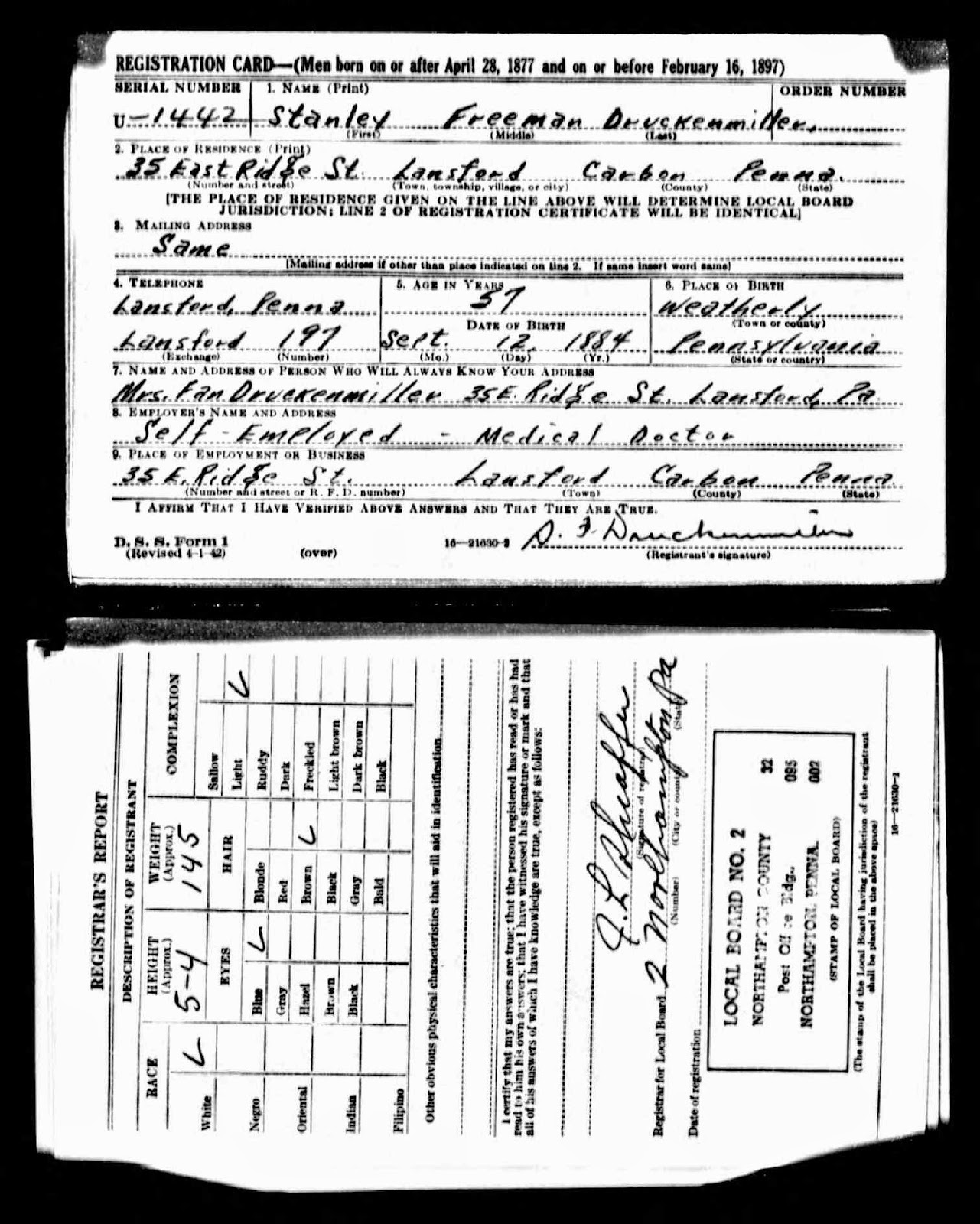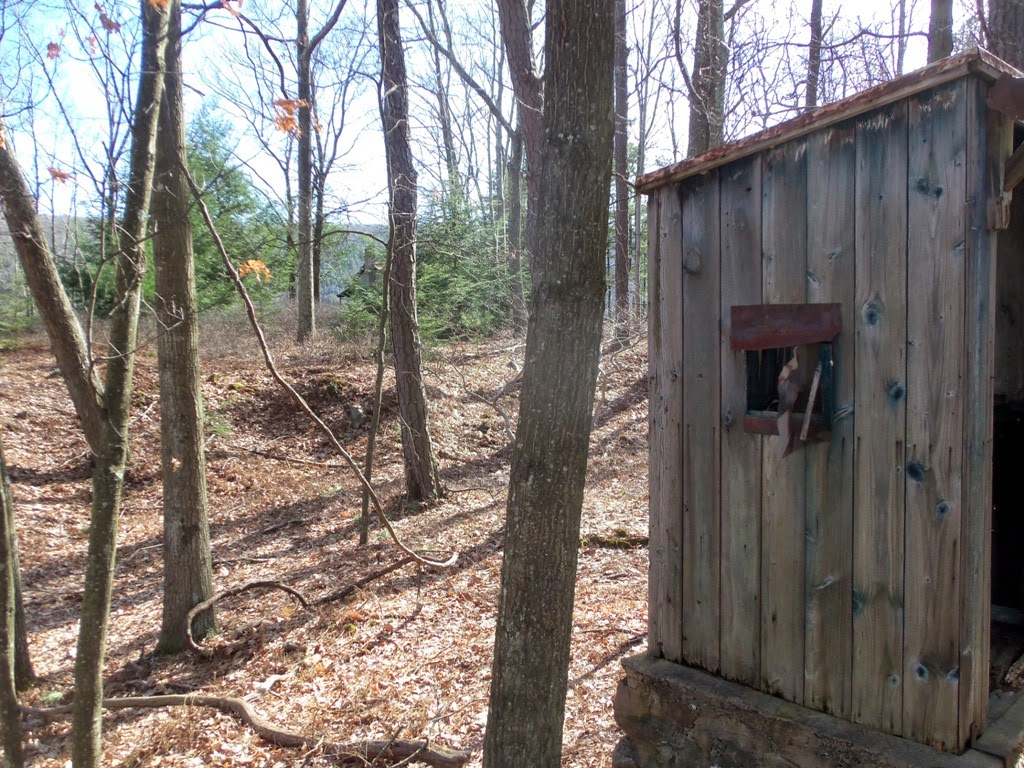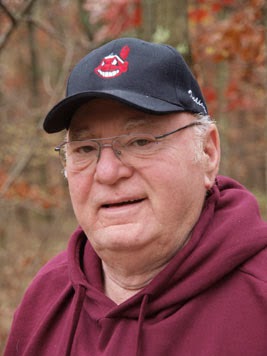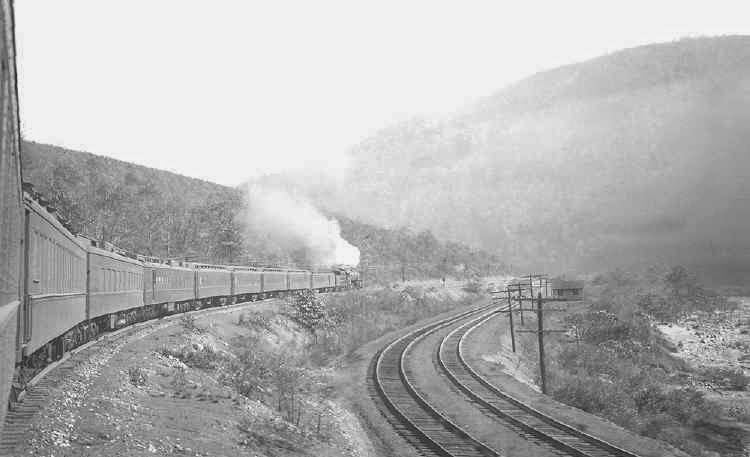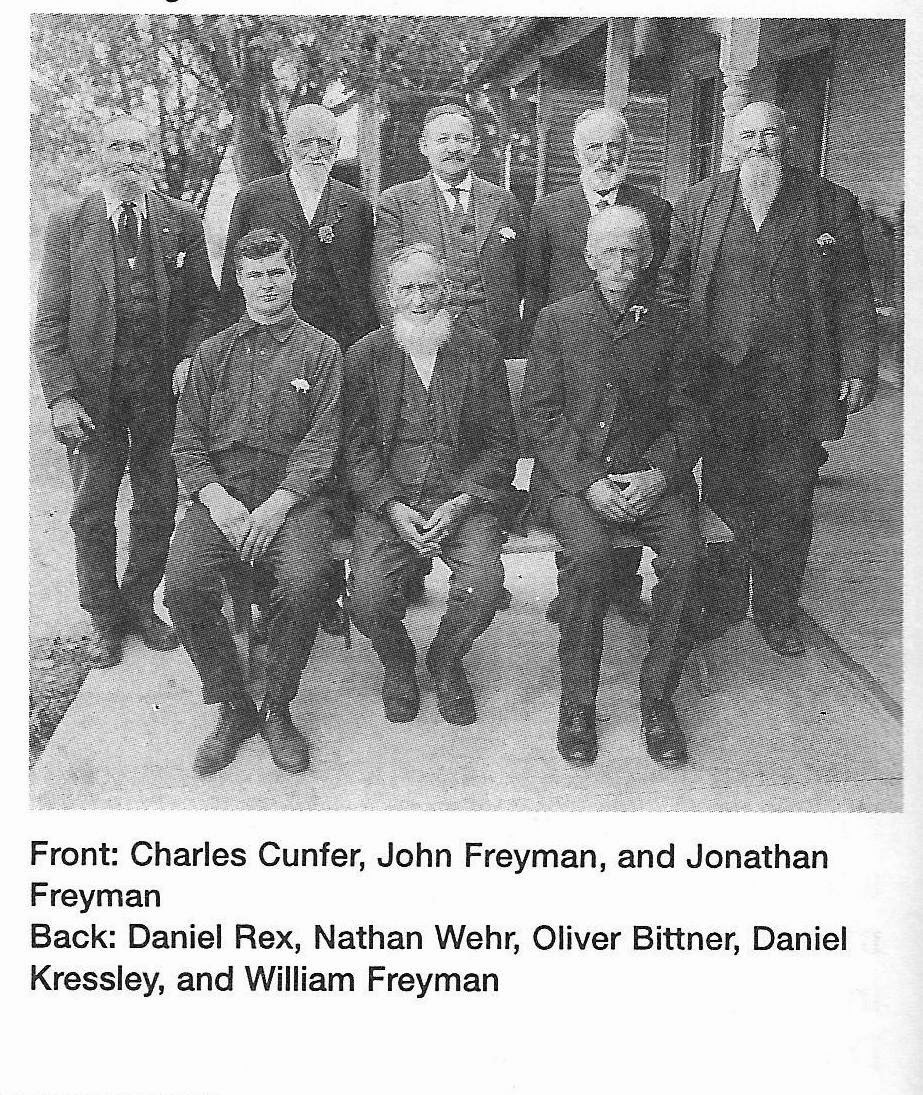Although this is Lehighton’s 150th year as a borough, its original founding reaches back to 1746.
Currently, a group of dedicated individuals is wrapping up several years of work to showcase the essence of Lehighton: a trolley tour, a talent show, a cemetery walk, revival of the Brothers of the Brush and Sister of the Swish, etc.
There will be all kinds of contests such as corn on the cob eating, trivia night, and the Coaster Races. The Coaster Races are said to have originated in Lehighton in 1923 and have been revived from time to time over the years. (See pictures of the 1950 & 1951 races at the end of this article.)
![]() |
| The Leuckel Building, most recently known as "White's Trading," in the 1980s it was Rea and Derrick Drugs seen here around 1942 with the opening of the Windsor Clothing Store. There for the promotional first night was the then Lehighton Boys Band, roughly 40 years before they changed to the Lehighton Boys and Girls Band. The Leuckel Building was completed in 1899 by Frederick and John Leuckel and once housed the post office and two banks. The expressions on the faces of the citizens in their hats and band members in their capes as well as the young girl looking down from the window gives this photo a classic Americana feel. This never before published photo appears here courtesy of Paula Kistler Ewaniuk, a descendant of the T.D. Clauss and Mahlon Kistler, both key Lehighton businessmen from the glory days of Lehighton's downtown. |
There will be an opening ceremony of the burying of men’s razors and women’s makeup as well as the uncovering of them on the last day. The park will have music each night with it all culminating with a fireworks display that will be seen from anywhere in Lehighton.
It could be easy to develop a romanticized version of life in those days. Often times the “good old days” are remembered as blissful times without strife.
Lehighton’s early days had a “wild west” mystique. There were saloons and cigar shops, and unsolved murders in our muddy streets. We had constables, horse thieves, and posses, but we had no jail. Once in 1870, a trio of banks robbers was caught here and was held captive in Mantz’s Hotel over night (see 1940s picture of First St below for the Mantz Hotel).
Constable John Weston formed a posse and cornered the desperate outlaws amid a fierce February snowstorm. The outlaws had swum the icy Lehigh to a hiding place in the woods across the river. This robbery also led to an unsolved murder of an unidentified man here in town over thirty years later (See footnotes for more).
Another story tells how the southern end of town was quarantined and several citizens died due to smallpox that Lehighton silk mill owner and town benefactor Eugene Baer accidentally brought to town from New Jersey in 1902. (See footnotes for more
& click here for more on Baer's Mill and family.)You name it, we had it: Rowdy council meetings with political backbiting, scandalous behavior at the fair including illegal gambling and drinking, as well as fraud and other crimes of all sorts, from the salacious sort to the comical and accidental.
Other Lehighton articles on this blog:
Lehighton Business of the Past Post #1: Maria Culton
Lehighton Business Post #2:
Lehighton Business Post #3: Young's Bakery
Haas' Store: Cal Haas
Lewis & Henry Graver articles
Moravian & Massacre Article
The Recluse of Lehighton: Frederica Misca
Two men who clashed in the 1890s were Burgess (mayor) Benjamin J. Kuntz and newspaperman George W. Morthimer. Kuntz, who succeeded Dan Olewine at his Seventh and Bridge Sts tannery, summoned Chief of Police Raworth to town council meeting to “settle down the rowdies.”
![]() |
The Lehighton Press of North First Street - David McCormick, son of locally famous Civil War veteran William Carpenter
McCormick in the press room with his longtime pressman Harry Miner. The two women are likely other longtime employees typist Alice Heintzleman and McCormick's sister, columnists Mary (McCormick) Ray. This picture and other valuable McCormick family primary sources provided by Bill and Kathy White of Lehighton. |
Morthimer was a member at that council and among other things, didn’t appreciate Kuntz’s allegations. However Morthimer’s power of the press (the “Fourth Estate” as they say) led to Kuntz’s undoing. Kuntz was mayor in 1879 and later again from 1891-92. However, his fourth run (as mayors seemed to serve only one year terms in those days) as mayor ended in November 1892 amid attacks from Morthimer’s “Carbon Advocate.”
Morthimer later served as mayor from 1903 to 1913. McCormick served from 1918 to 1921. By this time, it seems like the three-year terms had begun.
A March 1890 snipett in the Carbon Advocate announced B.J. Kuntz as "big, tall, tanner and Republican politician was a familiar figure on our streets on Wednesday." Morthimer was a Democrat. One of Morthimer's complaints about Kuntz was that not until after he lost the election did he complain about the illegal gambling at the fair grounds.
As of June 1910 Lehighton had three newspapers.
By 1902, Morthimer sold his "Carbon Advocate" to Attorney Philip M. Graul. One long-time employee of Graul was future Lehighton mayor William F. Hummel (1942 to 1953). But Morthimer would continue a South First St paper under the name of Lehighton’s “Evening Leader." His other competitor, David McCormick, ran the weekly “Lehighton Press” on North First. Both of these men were themselves involved in public office. (See footnotes for more on Morthimer and McCormick).
Graul's weekly "Carbon Advocate" raised its rate from $1.00 to $1.50 for its annual subscription. This was announced in February 1917, taking effect for 1918. Gaul was the first in the county to raise the rate, thought the other county papers soon followed. The Advocate burned in the early 1920s. Graul was appointed postmaster when President Wilson took office in 1913.
![]() |
George Williams Morthimer as
he appears in Brenckman's Carbon History of 1913
Morthimer ran the Lehighton Evening Leader.
Born 1866 - Died 1918. Buried in the Lehighton
Mausoleum. |
The Carbon Advocate had some advice for improving our town back in 1890: “Consider…Electric illumination, widening of the thoroughfares leading from Fourth St to the Fair Grounds, and from Alum Street to Kuntz’s tannery, a town hall and hose house and the beautifying of the two Parks. Cut this out and paste it in your hats.”
After several months of pleas using such phrases as "let there be light" and trying to shame the town for still using coal-oil because Lansford, Mauch Chunk, and Weatherly already had electiric street lights, The Carbon Advocate was pleased to announce in June 1891 that the town had secured a contract with the electric company to "illuminate the town."
Lehighton was of course founded by the Moravian settlers on the banks of the Mahoning Creek in 1746. It was part of what was known as the Moravian “Economy,” various industrious pursuits to make money for the mother organization to further its missionary work among the Indians.
![]() |
This letterhead among the papers discovered inside Guy Morthimer's copy of
Brenckman's Carbon County History from 1913. G. W. (George Williams) Morthimer took over the Carbon
Advocate from his father Harry V. Morthimer. And in turn Guy Morthimer took full control of the Leader
when his father passed in 1918. |
Lehighton was just one town of the many founded by the Moravians. Bethlehem and Nazareth were their first two settlements in the area as well as Emmaus in 1759. The Moravians also made settlements elsewhere, as far away as Georgia.
Lehighton was formed as an important stepping stone to the harder to reach native groups of the Wyoming and Susquehanna valleys. They lived in peace here but many colonial leaders had viewed these missionaries with at least some suspicion and perhaps a bit of contempt.
As the French and Indian War approached, laws were passed in New York barring Christians from spending the night among the native groups. This was aimed at the French Jesuit priests who lived among and ministered to the Indian souls they were trying to win over. Many felt the Moravians were simply French Catholics in disguise and were trying to infiltrate the English speaking lands
Fear of Indians led to an overall distrust of anyone who aided the natives. The Lehigh Valley then became a refuge for these exiled New York Moravians and their Indian cohorts when they were forced out of New York.
Another sticking point came from the Moravian blacksmiths. Though it was colonial policy not to provide the Indians with firearms, the Gnadenhutten blacksmiths were eager to help repair the flintlocks of any Indian who passed through here, and many did.
With British General Braddock’s western Pennsylvania defeat in July of 1755 came fear of further Indian reprisals would move eastward.
They of course were right. Attacks were made on many area settlements, but the peace and good relations the Moravians established here made them feel impervious to any hostility. And as the story goes, on the evening of November 24th it all came to an end here. Many of those attacked here had only been in this country for a few weeks.
Not all were killed. One husband and wife became separated: she spent the night in the hollow of a tree and he ran to Bethlehem and back through the night, to get help. They were reunited in the morning, each fearing the other had died.
And had the 16-year-old lad Joseph Sturgis not jumped from the burning attic and lived, we may not have the pretzel today. He went to live at another Moravian settlement in Lititz and was a successful potter.
His grandson Julius Sturgis developed the first commercial pretzel bakery in the country.
(More of this including information of those lost and those who survived can be read here.)Few people realize that one somewhat mysterious woman came to live on these grounds. Here purpose was to venerate the martyred souls lost here. Her name was Fredericka Misca.
(More of her can be read here: )Jacob Weiss of course bought some of the Moravian lands on both sides of the river. And another highly industrious man named William Henry partnered with him. Henry learned the gunsmith trade in the Moravian settlement of Lititz before moving to Nazareth. When the mission here faded, the Moravians found an eager buyer in Henry and Weiss.
The timing of this venture was enhanced with Josiah White’s successful launch of the coal trade, first on the river with his “bear trap locks” and later in 1828 with the Lehigh Canal, leaving the lands of Weiss and Henry open to the future promise of the industrial settlement of Lehighton. (More on Josiah White can be found here.)
Speculative minds and hard working hands soon followed.
Of the first industries here were grist mills and leather tanning. There was a mill sluice and run that ran parallel and along today’s Route 209 bypass, behind today’s Lehighton Hi-Rise.
Later Moses Heilman had a grist mill on the Mahoning Creek and a large dam behind what is today’s Boulevard Restaurant. He also had a feed mill on First Street. He last lived at the corner of Third and Alum Sts.
In 1915, the Burd brothers well-diggers found three human skulls near Heilman’s dam, which was just downstream from where Henry Graver would build his ice dam and pond. The skulls were thought to be from the colonial days of the Moravians. Some speculated these were Indian skulls.
However, another theory that should be considered would be those of the six men Ben Franklin hastily buried along the banks of the Lehigh when he came to build the fort in Weissport in January 1756. About six colonial militiamen were lured into an attack on New Year’s Day that year.
Heilman was just one of many of our town’s “pioneer” residents.
Another was Lewis Graver, father of Henry, the patriarch of the many Graver enterprises here. Lewis came to timber the Moravian lands as a youngster of twelve with his father and was an early boat builder with his brother Andrew. They had a boatyard at the canal and were also leather tanners.
![]() |
Here is a view from the Carbon House looking south on First St Lehighton around the 1940s. You can see the Elk's
Building, destroyed by fire in 1934, is refurbished here with the A&P Store in residence. Also, G.C. Murphy, Hotel Lehighton (now the Hi-Rise) and further down the "Mantz Building" with its ornate top (most recently Renee's Beauty Shop). |
Lewis Graver’s son Henry later ran a brickworks, ice house, and skating rink. He also built two of Pennsylvania’s largest cement swimming pools.
First here and another in Lebanon PA in the 1920s (Read more about this family here:). Lewis also had two daughters with business sense.
Alvenia and Adaline were milliners in town (Read more here):Eastern Pennsylvania, but especially northern Carbon County in the Pine Swamp and Hickory Run area, held plentiful reserves of hemlock pine trees.
Hemlock (and oak to a slightly lesser degree) bark was preferred for the tanning of hides into malleable leather because of its high tannic acid content. So the fact that Lehighton had no less than two well-established tanneries should come as no surprise.
The first tannery in town is believed to be started by David Heller in the area behind First Street in 1820. It was in the vicinity of where G.C. Murphy was operated a department store, across the narrow street of today’s Hi-Rise.
This tannery property was eventually developed into what was known as the “Linderman Block, so named for Asa Packer’s son-in-law,
Dr. Garrett B. Linderman.Dr. Linderman came to Mauch Chunk in the great cholera epidemic in 1854,
falling in love with Packer’s daughter Lucy. (Read more here: )It is unclear whether Heller sold his interests directly to Stephen Kistler (
no direct relation to Lehighton’s Daniel "Jacob" or "Jake" Kistler). After Stephen left to develop his Tannersville properties, he left the Lehighton tannery in the hands of his brother William. However one newspaper article mentioned a tanner and animal fertilizer business owned by a Benjamin J. Kistler (not to be confused with Lehighton tanner Benjamin J. Kuntz.)
Kistler came from Kistler Valley to start his first one of the four tanneries he would eventually own. At his death, it was said that he was the wealthiest tanner in the state and perhaps the nation.
He lived and operated a larger one in Monroe County’s “Tannersville” as well as two in Susquehanna County.
![]() |
| Owen W. Snyder once owned this fine Victorian-era home on the corner of Second and Alum Sts. Snyder was a horse surgeon born in the Kistler Valley, Lynnport in 1860. He died of heart failure in 1922. He and his wife Amanda did not have children, though they did raise her nephew Arnold Rusell (born 1912). Snyder lived first in the Mansion House Hotel when he arrived here in the spring of 1887. By 1890 he was living near Kistler's Livery at the Carbon House. Since this is most likely Snyder and his nephew Arnold who looks to be as young as maybe 5 or so, this picture is probably taken around 1917 or so. The house was later owned by widowed physician John Hammel, father of two well-known Hammels: William and Andrew. Currently Gregory Duschak is refurbishing the home and it will be for sale. (Picture courtesy of the Brad Haupt collection.) |
![]() |
| Here is a modern view of the three Queen Anne sashes in the attic tower of the Snyder home, currently being refurbished by Gregory Duschak. |
Owen W. Snyder lived in a handsome Victorian-era home on the corner of South Second and Alum Sts (currently being refurbished by Gregory Dsuchak). He was a veterinarian surgeon, specializing in the many horses that kept Lehighton running in the early days.
Born in the Kistler Valley, he attended the "celebrated" Ontario Veterinary College. Snyder made the papers frequently, known for his cure for tetanus in horses, he performed hernia operations, and removed tumors. He was also always prepared to put a horse or cow down if he had to. Dead animals were then taken to B.J. Kistler's animal fertilizer plant in Jamestown.
The gambling in town most definitely centered on the Fair's horse racing. Purses of $100 or more were often touted in the papers. Horses from places like Stroudsburg and Allentown would come here to race our local mares. Snyder was known for always having the nicest, newest and fastest mares as the Carbon Advocate would often announce. He and Jonathan Kistler were known to trade gray mares with each other as well as Snyder buying from horse trader Knaus and others in Allentown.
Snyder encountered a run of some paid luck starting in the fall of 1902. In September, a half-drunk horse thief entered town and made off with one of Snyder's thoroughbreds and one owned by William Walters of town. Unknowingly, the Rev G. G. Kunkle of Mauch Chunk accepted a ride from a "half-drunken" man who drove him from Packerton down the Mansion House hill.
Rev Kunkle said the man drove so recklessly that he tried several times to have the man stop and let him off. However he drove the horse so hard and into the wall that the horse died. Kunkle walked home, thinking little of it until he heard of the horse thefts. The next morning the dead horse of the Mauch Chunk mountain road was found to be Snyder's valuable track horse.
It is believed the horse thief went back to Lehighton and then stole the Walters' horse. That horse was found dead a few days after on the Blue Mountain.
Then in early June 1903, Snyder's stables were struck by lightning and two of his horses were killed. It did not mention the specific location of these stables. One article in 1893 implied he owned stables on Seventh St and was trying to get council to open up Alum Street through to his property there. His stolen horse was valued at $750, a vast sum in those days.
Following Snyder in this home was Dr. John Hammel, father of Hammel's Store owner William Hammel. William was a magician in the old vaudeville days before opening the store at First and Coal Sts.
His brother Andrew was a projectionist at theaters in town before opening Hammel's Gas Station near today's Mahoning Elementary school (the small white shed on the opposite side of the road was the station and is still there.) He was also the projectionist at the Mahoning Valley Drive-in for years.
Lehighton the Borough was only six months old when the famous Dan Rice Circus came to town in June. A one “mile-long” parade was sent down First St to try to lure townsfolk into the show at fifty-cents a head.
However, as one team of Rice’s horses approached the lower park, the team became “spooked,” supposedly due to the severe from Kistler’s tannery.
The team made a deadly trot toward one of Lehighton’s earliest hotels, the “Carbon House,” which sat on the corner of First and North Streets (below today’s library). Some reports say it was a Mauch Chunk man, others that it was a man from the Mahoning Valley, who was killed (or so severely injured he wasn’t expected to live) trying to arrest the team.
(Read David Carlyon’s book “Dan Rice: The Most Famous Man You Never Heard of.”) Rice was once considered for candidacy for president.
![]() |
The Carbon House, from North and First Sts,
at the corner below the library ~ Circa 1900. |
Another Lehighton tanner and pioneer resident was Daniel Olewine. He and his wife Esther (Zoll) originated from Towamensing Township. Olewine first journeyed to Mauch Chunk as a tanner. But by 1856 he built his own enterprise at Seventh and Bridge Streets in Lehighton in 1856.
Today the former Penn Lace building stands where the tannery once operated.
Olewine was a founding president of First National Bank in Lehighton in 1875. This bank was first housed in a portion of Joseph Obert’s First St residence in the 1880s.
The bank later became the Hazleton National Bank that opened for business in its once thoroughly modern stone-façade building. Though now vacant, it is still an impressive downtown building that first opened in 1910.
Olewine’s tannery burned down in 1873. At that point he retired to his spacious brick home next door that still stands at 600 Bridge St. As mentioned earlier, the tannery was then rebuilt by B. J. Kuntz who operated it into the 1890s.
Daniel Olewine was father-in-law to two well known Lehighton residents: Chief clerk of the LVRR Car Dept Franklin Pierce Lentz (Clara Olewine) and William S. Koch (Susan Esther Olewine) of the well-known Koch farm in southwest Lehighton.
![]() |
Isborn Koch and his brother William S. once ran a cigar
factory in downtown Lehighton. Their partnership
dissolved in 1882. I.S. continued on while W.S.
went full-time into farming. |
William was just one of the first three Koch brothers to live in Lehighton, all sons of Daniel and Mary Ann Koch of Northampton County. Besides, William there was Isborn S. and Milton. Until 1882, Isborn and William were in the cigar manufacturing business together in downtown Lehighton.
Isborn continued in cigars while William furthered himself in his large 200-acre farm in the southwest corner of town. (One of several unsolved Lehighton deaths was once solved by I.S. Koch, search this story for more on that).
A portion of this farm became the Small and Koch Dairy Farm with William’s son and son-in-law Reuben Koch running the dairy until the mid 1930s. It later became Geurstlaurer’s and still operates today as Zimmerman’s Dairy.
![]() |
From the horse drawn days of Small and Koch Dairy. Originally started on William S. Koch's farm by his son William "Daniel" Koch and son-in-law Reuben Small, they first called it Orchard Poultry and Truck Farm. Reuben Small
arrived in the Lehigh Valley for business school and met and married 'the farmers' daughter' Esther Koch
in 1905. Small and Koch operated the farm until the mid-Depression. (Small & Koch photos are courtesy of Lois Small). |
![]() |
| Reuben Small (left) and William "Daniel" Koch left in the early 1900s at the Small and Koch Dairy in the southwest corner of Lehighton. |
Small and Koch Dairy was the first Carbon County dairy to pasteurize milk. It was also the only diary of the over 268 in the county to receive a state department of health satisfactory rating in 1916. (See footnotes for more on Reuben Small).
Lehighton was also home to two of the three Lentz brothers from Colonel John Lentz. Col Lentz was a soldier in the War of 1812 and later, though advanced in age, led a defense of Harrisburg when Lee’s army advanced there in the summer of 1863.
One of these sons, Lafayette of Mauch Chunk, made a fortune in the coal fields. Lentz Trail along Mauch Chunk lake and creek is named for him.
Lafayette’s son, Horace DeYoung Lentz, graduated Harvard Law in 1891. He in turn endowed a scholarship there that still provides full tuition to any Carbon resident who attends Harvard Law. Current resident Neil Makhija of Lehighton is the only living person who has benefitted from this trust.
Here in Lehighton, John S. Lentz lived at Third and Alum Streets, today’s “Schaeffer Funeral Home.” He was superintendent of the Packerton shops.
Franklin Pierce Lentz lived at the former brick home of his father-in-law Daniel Olewine. He held various positions with the LVRR including chief clerk of the car department at the Packerton Yard as well as Justice of the Peace in Lehighton. He was educated at Lehighton’s “Academy” school.
![]() |
The crowning achievement Frederick Leuckel's life of work in Lehighton, his 1899 building still stands today. Neither Frederick and his son John who completed the building would live long to enjoy it.
Both men were dead by October 1899. (Most photos without photo credit are from the Haupt family collection). |
Another pioneer immigrant of Lehighton was Frederick Leuckel, his building is still prominent in the downtown. Born in Germany in 1807, Frederick Leuckel came to America by way of Amsterdam with $40 to his name.
He apprenticed there for seven years as a butcher. He then made a 130-day voyage to New York City at the age of twenty-three. He worked in the sugar factory in Easton and started a meat shop there before moving to Lehighton. He married another German émigré Lecetta Lenzler.
Leuckel rose to financial prominence from the hard-work of his butcher shop, to investing in real estate, banks, and other businesses. He was a major shareholder in at least four banks: two in Mauch Chunk, one bank in Catasauqua, as well as in Lehighton’s First National.
By the time of his 1875 “retirement,” he was one of our town’s wealthiest self-made men.
![]() |
This circa 1908 fire next to the Leuckel building led the way for
Citizen's National Bank to construct its stone facade building next door
in around 1909. |
The ‘Leuckel Building,’ completed in 1899, was the former home of Lehighton’s post office and was home to Leuckel’s and Olewine’s “First National Bank.” It later housed the “Citizen’s National Bank.”
A fire next door around 1908 led the way for “Citizen’s” to build its prominent stone-façade modern bank building next door. First Federal, the last and most recent bank that occupied this building, added a more modern metal face to it in the 1970s.
Lehighton has had its shares of fires. Many of these will be detailed in 25 stop trolley tour guide book being published by the Sesquicentennial Committee. But many businesses have been relocated or otherwise affected by the many downtown fires over the years. The tour book will chronicle the major ones from the 1930s Elks fire, to the 1950s North First St and the 1960s South First St fires.
![]() |
Here is the bunting of the opening
of the new Citizen's National Bank
building with the Leuckel
Building to the left. The building
still stands today, however the last
bank, First Federal, covered it with
a more modern looking metal facade. |
![]() |
Serfass Motors before May 1918 fire - Looking north on Iron St,
with the former Trinity Lutheran Church tower at Third and Iron
in the distance. |
Serfass Motors burned to the ground in May of 1918 and a three-story brown brick building went in its place. (It is currently a Blue Ridge Cable office behind the former Times News building.)
Within the personal collection of dairyman Reuben Small are pictures of burned out cars from a "Lehighton garage fire." Though no one is certain these are of the Serfass Motors, it is certainly a possibility. These photos will appear at the end.
![]() |
This is the Serfass fire from May 1918, taken from the south side of
Iron St, looking toward the alley behind what would one day by the
the Opera House/Bayer Building/Times News Building. The long
building in the background was the original band hall and still stands. Look at the end of this story for fire pictures from the Reuben Small personal collection from this time period. |
Eventually, sometime before 1946, Moyer and Haupt had their first garage there. By 1946 they took over the former Acme building at 200 to 206 North First St and began moving their Ford dealership there, this being another currently building housing BRC offices today.
Later, Moyer and Haupt moved out to Route 443 with an Edsel dealership, this dealership now trades as "Lehighton Ford." They also operated a service station at the corner of Eighth and Mahoning Sts, today it is a medical center in the 1940s.
![]() |
Moyer and Haupt on Iron St pre-1946. Not the brick ornaments
above the row of windows. Those can still be seen today on
this building currently housing some Blue Ridge Cable offices
at the alley behind the former Times News Building. |
![]() |
This picture shows Moyer and Haupt converting the old Acme
back into a garage. Prior to it being Acme, it housed Otto Kropp's
First St garage. Today it is the main Lehighton BRC office. |
Prior to the Acme occupying 200 North First, Otto Kropp had a garage there. He also had a Studebaker and Hudson dealership in the area of our current library. Otto must have been quite a character. It has been said that he once made a late-night car-swap deal with gangster "Legs" Diamond, a bootlegger who operated between New York and Philadelphia.
In 1937, Otto and his wife hosted Dr. J. Lavarowitz who was president of the "Rambling Hobos of America." Otto was the grandfather who raised the well-known Lehighton geography teacher Michael "Corky" Kordilla.
Another well-known Lehighton business that grew, burned, and moved to another street was Kistler's Hardware.
![]() |
Here is Mahlon Kistler (left) and business parnter William F. Hamilton in his mid-1920s First St Hardware Store.
It transferred to his son Mahlon "Jake" in 1957 and later to his
step-son George Griffith. The store continues today on Second St as "Lehighton Hardware." Hamilton was born in Scranton and was a boilermaker for the LVRR in 1910. He died of a stroke in 1935 at the age of 50.
(Kistler pictures appear courtesy of Paula Kistler Ewaniuk.) |
Kistler’s Lehighton Hardware would later move to Second Street, its current location. Kistler started his hardware store in 1925 and ran a progressive business model, taking pride in decorating his front window. In 1957 he handed the reins over to his son Mahlon Jr. In 1963 they were burned out and moved to its current location on Second St. The business went from Mahlon Jr's step-brother George Griffith.
![]() |
| The show window of Kistler's first hardware store included shotguns, shells and stuffed raccoons. See the end of this story for the new store front further up First St that later burned in a 1963 fire, sending the store to Second St. |
Curiously, Kistler's Hardware was located at 237 North First St, in what would be in today's Rite Aid parking lot. After the fire, the A&P, which was then located in today's Lehighton Hardware's Second St building, built the 14,000 square foot building Rite Aid uses today. The A&P left the current Rite Aid building back in the 1980s.
One of the longest tenured corner grocery stores in Lehighton was Cal Haas' store at the corner of Fifth and Coal. It served their neighborhood with credit for groceries from 1930 to 1996. The last thirty years it was ron by Cal's son Robert "Bobby" Haas, who was known for his regimented scheduled coffee breaks at the Beacon 443 Diner.
![]() |
Here are some of the Haas family from the 1955 celebration of
the 200 year anniversary of the Gnadenhutten Massacre. From Left:
Robert Haas, his wife Geri Haas, Cal Haas, and daughter
Madeline (Haas) Kreiss Folweiler. (Madeline's first husband
Ezra Kreiss was lost in Operation Tiger in WWII. She re-married
Chester Folweiler, another WWII veteran. |
The Trainer family had a corner store on Third and Cypress Sts. It was taken over by Mel Everett and Dick Koch as "Ev-Ko" furniture and home appliances in 1966. A fire destroyed the business in 1968 and the pair split in 1974. Everett continued there in furniture and Koch established himself on Coal St where they remain today.
Mel's brother Arlington "A.W." Everett's furniture frame business in Franklin Township is also still running today, though now they specialize in frames for lift chairs.
Like Leuckel, Joseph Obert was another German immigrant butcher who prospered here. He opened a dry goods business in Lehighton in the 1870s to which he parlayed into farm land speculation.
He eventually built one of the largest pork and cattle processing and packing plants in the east. His sons continued the business into the 1930s.
Livestock would arrive on the LVRR and enter Obert’s stockyard on the east side of First St. Pigs and cattle (but mostly pigs) were then marched across the street and up the alley between what is today Alfie’s Pizza and the former Hinkle’s Downtown Grille (a building first built by Obert and once held “Malta Hall” on the second floor.
![]() |
This building still stands across the alley from
Obert's (today's "Alfies") and was built by Obert
after the "Lyric Theater" was torn down. It was
home to Losos and Sondheim clothiers (who
once occupied part of the Obert building).
The second floor once housed the Knights of
Malta and a portion of Obert's slaughter
house can be seen rear left. Look for interior
pictures of this building at the end of this
article. Most will also remember the most
recent owner of this building was
Hinkle's Downtown Grille. |
The large slaughter house was located on what is today a municipal parking lot behind Alfies. The block across from this alley, once was known as the Obert block.
The Obert’s lived at both his sprawling building in front of his slaughter house on First Street as well as another home he built later on South Second near Trinity Lutheran Church (now owned by Barrett Ravenhurst and Rick Brong).
![]() |
The beautiful Victorian-era home was first built by Joseph and Catherine Obert in the 1880s or 1890s at
212 South Second, catty-corner from Trinity Lutheran Church and is one of the 25 stops of the Sesquicentennial
Trolley tour. Seen here in this photo is Joseph and Catherine's son William and their grandson Horace
Obert Sr. William's wife was Florence. Horace Obert Jr was the long time chiropractor in Lehighton up until
is recent retirement a few years ago. The new and only third owners of the home are currently Barrett Ravenhurst
and Rick Brong. |
The three Gaston brothers (Carson, Wayne, and LeRoy who run the pizza shop), are the current owners of Obert’s First St property and have done well maintaining the building’s former glory.
![]() |
This picture gives quite a glimpse at the classes of society of early 1900 Lehighton. The Victorian-era garbed
ladies and gentlemen on the yard versus the blood-stained work clothes of the man in the street. You can
also see Loso's and Sondheim's former location before moving across the alley. |
It is here where we can see the meeting point today.
By studying the many buildings in Lehighton and by getting to know our history, we can see where our past meets our future. The Obert and Leuckel buildings are a good place to start.
The once ornate dental work and finials are gone. The large rectangular sign that proudly touted the “Leuckel Building 1899” now says “White’s Trading.”
Just like the once powerful anthracite and transportation industries are likely never to return, the works and fortunes of our pioneer residents are also mostly long gone.
But we are here today because of them. And their legacy to us is to live in a town where their dreams once prospered. It is for us to fulfill that potential as we are fit to do.
Footnotes:Lehighton Deaths of the 1890s:The 1890s were hard on many of Lehighton’s most prominent pioneer citizens. Lewis Graver died in January 1892 (just weeks after his and Leah’s 50th wedding anniversary).
Joseph Obert died in June of 1897 at the age of 76. He once donated the land at the corner of Second and Iron to build Zion’s United Church of Christ.
Moses Heilman died in May of 1898.
Also, two sons of two early Lehighton tanners died prematurely in 1898. Daniel Olewine Sr died at seventy-nine in March of 1895. But his son Daniel Irwin Olewine died of typhoid fever in Philadelphia in January 1898 at the age of forty-two.
Another Lehighton connected tragedy occurred in May of 1898 when Burgess B. J. Kuntz’s son Edward was seriously injured from an exploding gasoline tank at a Missouri steel company. He had just begun working there as a chemist.
Upon receiving the news via telegram, Postmaster and former tanner and mayor Kuntz immediately left for Missouri. However he was unable to reach his son before he passed. His remains were shipped back to Lehighton for burial. Edward J. Kuntz was only twenty-five.
Ironically, in 1899, in the same year that their building was completed, both Frederick and John Leuckel died. Frederick in June and his son John died unexpectedly in October from stomach difficulties.
Incidentally, John Leuckel’s mother-in-law, who was also the mother of Lehighton’s well-known planning mill owner Henry Miller died in an unfortunate accident just months after John’s death. Mrs George Miller died at the age of 79 from a fractured her skull after falling into the family well at their Franklin home.
~~~
The Wilkes-Barre Bank Heist in 1870 leads to arrests and a murder:My favorite story involves a pair of bank robbers who hit a bank in Wilkes-Barre in 1870 who came to Lehighton to lay low. The four suspicious men were “loafing about” Mantz’s Hotel (in the block south of the Hi-Rise today) and rumors quickly spread around town about the character and deeds of these men.
Forty year old Constable John “J. T.” Weston took the gossip seriously. The robbers instantly drew their guns on the constable’s approach, making their escape out the back of the hotel. And though it was February, they crossed the LVRR tracks and went into the river, all the while during a “raging snowstorm.”
Weston gathered a posse of men, all armed, and made their way to Weissport, to the vicinity of old bottling works (behind Hofford’s red-brick mill at the end of the bridge owned today by Tom McEvilly) where the crooks were said to leave the river.
The men were captured later, but not without resistance. Their attempts to fire at the posse were in vain as their weapons were too wet from their mid-winter swim. Rumors quickly spread that the $30,000 in cash, bonds, and securities were stashed on the mountainside somewhere opposite of Packerton dip, in the Long Run section of East Weissport.
The robbers were sentenced to 20 years in the Eastern State penitentiary and were said to have died there. However by 1906, it was speculated that they communicated the whereabouts to other prisoners who upon their release came to town to claim the treasure.
In May 1906 three strangers arrived in town, at least one of them was well-dressed and seemed to be carrying a large sum of money. He and a friend got into fisticuffs in a Lehighton “saloon” in the afternoon, the friend threatening to have the other arrested.
Later, word spread through town that these men, along with another man, were seen digging in the area of the missing bank loot. That night, three shots rang out in a yard of a home on the outer edge of town.
They found the well dressed man with three bullets in his lungs, with the muzzle blast burned into his clothes, shot at close range.
Suicide was ruled out. He had a watch and about $35 on him. Authorities suspected the clever perpetrator left a small portion to give the appearance of suicide over robbery.
Constable J. T. Weston was born in Carbon’s “frontier” logging settlement of Sandy Run. He died in Allentown in 1914.
~~~
Lehighton's Three Stone-facade Banks:At about the same time Citizen's Bank was going in, the Hazleton National Bank arrived in town and likewise wanted to build an impressive structure to lure Lehighton's abundant cash flows. Hazleton took over the former First National Bank.
First St was once known as “Bank St," most likely referring to the street closest to the bank of the river.
The Hazelton Bank building was opened in December of 1911, and for the convenience of a parking lot and modern drive-up window, moved to the corner of First and North Sts in 1963. The original stone face of Citizens Bank has long been obscured by metal-work meant to give the old bank a “modern” look. It was most recently known as First Federal Bank. Another bank, on South First, was once known as Dine Bank in 1916, then later Bank of Lehighton, then People’s Bank, and most recently PNC Bank.
Next to the former PNC Bank building was once the regal looking hotel owned by Alvin Hausman, which was later run by his son Howard Hausman. Howard's son Willard graduated from Lehighton High School Class of 1927.
Alvin's hotel was torn down by People's Bank to make way for a parking lot. This picture shows Alvin standing at post, with his son Howard at the wheel of the car along with grandson Willard.
![]() |
| This is the Alvin Hausman hotel as it appeared on First St around 1920 (Willard, the boy in the car was born in 1909). This was torn down to make room for People's/PNC Bank's side parking lot. Note two things: You can still see the steep gables of the building to the left in today's green-painted "14-Acre Farm" Deli (formerly Lehighton Bakery). Also note the edge of the building on the right has balcony woodwork that matches Owen W. Snyder's balcony woodwork. The fact that both this hotel and the Snyder property picture show their respective buildings festooned with our flag leads me to believe it was an important anniversary year. The 150th Centennial of our nation would have been 1926, however that would make the boy Willard in the passenger seat to be 15 or 16 and he is certainly younger than that. Perhaps it was the 50th year of our town, which would have been 1916. |
![]() |
The woodwork of the railing of Dr. Owen Snyder home today being
readied to be remounted to the balcony is the same pattern as the First
Street building next to the Hausman Hotel pictured above. |
The McCormicks of the Lehighton Press:Publisher David McCormick was the grandson of Mary Mockler. In her obituary of 1900, Mockler was described as a longtime resident of Lehighton with an ever clear mind. She was well versed in world and local affairs due to her extensive reading. Her first husband David McCormick was born in Ireland in 1804 and died here in 1854.
But when the Civil War broke out, her new husband, Dr. William Mockler (also of Ireland) enlisted along with her three of her sons, including William Carpenter McCormick. Mockler was fatally killed at Fredericksburg and the twice widowed mother lived out her years with her son W.C.
William Carpenter McCormick, father of publisher David owned a bit of Civil War celebrity. After the war, McCormick was known to be among the people to personally guard ex-Confederate President Jefferson Davis. The two grew in friendship and mutual admiration for each other.
A current Lehighton-area resident, Larry E. Ahner of Long Run had a similar experience. Ahner was given command and control of guarding Saddam Hussein after his capture during the Iraq war. Ahner had daily, personal, one-on-one contact with the reviled dictator. Ahner is hoping to one day write a book of this experience.
After the war, the McCormicks first lived at Hickory Run, working for the logging families there, which is where David and his siblings were born. Two of those siblings died as toddlers and are buried in the peaceful little cemetery near the park office, surrounded by majestic 200-plus-year old hemlocks.
![]() |
The quote on James and Thomas McCormick's grave at
Hickory Run reads: "Suffer them to come unto me and
forbid them not." |
Prior to the McCormick family arrival in Hickory Run, there was a devastating flood there in October of 1849. Due to the over timbering of land and the steep and narrow terrain, flash flood waters rushed unabated into three dams, one of which owned by logger J. S. Gould (it was a 70-plus-acre dam) and two owned by Mahlon Taylor, gave way.
Most of the family homesteads were wiped out, children, fathers and mothers were lost. One well-respected blacksmith of that area lost his wife and four children that night. He survived them by forty years and was one of the last people buried in this nearly forgotten cemetery.
~~~
The Morthimer & McCormick Rivalry:
Not only did the business and political rivaly spill into their respective papers from time to time, but I have in my possession G.W. Morthimer’s copy of Brenckman’s 1913 “History of Carbon County.” Based on his handwriting and notes in the margins, Morthimer apparently regularly consulted this copy when preparing articles such as obituaries of Lehighton’s leading people.
Brenckman’s book of course was written in rather flattering language. However, when David McCromick died at the age of 60 of a heartattack in 1933, allowed Morthimer to write his rival’s obituary.
The Evening Leader’s copy is fairly true to Brenckman’s biography with a few edits. Morthimer’s pencil crossed out words like “well-known” and striking out phrases like “The Lehighton Press faithfully mirrors the important happenings” with “No” written in the margin.
McCormick had also been postmaster of Lehighton several years after Morthimer’s tenure. McCormick was also treasurer of Lehigh Fire Company and was the first person of the newly formed “Loyal Order of Buffalo” lodge in Lehighton in 1912.
The “Lehighton Press’s” David McCormick was also involved in politics, running for some of the same offices held by Morthimer. McCormick was the son of the locally famous Civil War veteran W.C. McCormick.
![]() |
One of David McCormick's palm cards from his
mayoral run in the early 1900s. |
Given the prominence of his father’s veteran status, gives little wonder in his chairman’s role in the Sons of Veterans organization. This group held a large encampment at the Lehighton Fair grounds in the summer of 1916.
Members from all over the county and beyond came to parade, drill, and wake to reveille each morning in a week long camp out during the first week of July. They even fired guns on the grounds of the fair. Lehighton won the right to host this annual event over Weatherly’s application due to McCormick’s persistence. Several letters of correspondence for this event still exist and are included here.
The final edition of the “Lehighton Press” ran on Christmas Day 1947. With David’s passing in 1933, the paper was published by son Robert David McCormick. In the end, the final three employees were: linotypist Alice Heintzelman, Robert’s sister and columnist Mary (McCormick) Ray, as well as Harry Miner who was a 54-year employee who worked as typesetter and printer for most of his career but also as reporter.
Miner was of the old Weissport Miner’s. This family was deeply involved in Weissport’s past from postmasters to the Fort Allen Iron Works.)
George W. Morthimer took over the Evening Leader from his father, an immigrant from Scotland. He was county auditor in 1893, a member of Borough Council and the board of education in town. He himself became burgess as it was then known in 1903 and ran again in 1909 unopposed. He was also Assistant Postmaster of Lehighton during Grover Cleveland’s first term in the late 1880s.
~~~
![]() |
Handwritten notes of Guy Morthimer from the
news of the day, August 1, 1924. |
![]() |
A typed letter from David McCormick of the
Lehighton Press 1918. |
Reuben Small of Small and Koch Dairy:![]() |
Employees of Small and Koch in 1926. The very front and center gentleman is Reuben Koch. On his right is
his father-in-law William S. Koch and to Reuben's left is William Daniel Koch. The man to the right of William S. looks like one of William S.'s brothers. Isborn Koch who was formerly in business with his brother died in 1930.
The taller woman left of the post is book-keeper Rachel Strang who one day pronounced to all that she would one day marry Reuben. And they did. |
Reuben Small came to the Lehigh Valley from Massachusetts to attend business school. Along with his education, he married Mary “Esther” Koch 1905 and created one of Carbon County’s best early dairies. William S. and Susan (Daniel Olewine’s daughter) Koch owned the southwest 200 acres of Lehighton next door to the Olewine homestead.
The first enterprise of Small and his brother in law, William “Daniel” Koch on the Koch land was to form the Orchard Poultry and Truck Farm. Soon after it became the business traded as Small and Koch Dairy.
But then it appears that Reuben had a few missteps in the early years of the Great Depression. He built a large brick home (the home directly behind the PennDOT building on Ninth St today) and apparently misapplied money from the dairy for its construction.
His marriage to Esther also ended and Reuben married the dairy’s bookkeeper Rachel Strang. Strang once grandly pronounced to Esther that she would one day steal Reuben away from her.
Eventually bought out by Gerstlauer Dairy, Small moved back home to Massachusetts with his second wife Rachel. The well-known and recently departed WWII veteran of Mahoning Valley, Chester Mertz, was a relation to the Smalls and visited them often, helping out on their Westport dairy farm.
Gerstlauer’s operated well into the 1950s until it was taken over by the Zimmerman family of New Mahoning. Zimmerman’s of course is home to the champagne of Lehighton, Zimmerman’s Dairy ice tea.
~~~
![]() |
Reuben Small and his family and friends loved hunting in Potter County. The more well known picture of them at the Lehighton Park appeared in Ebbert and Ripkey's Lehighton book. These photos all appear courtesy of Lois Small
of Westport, Massachusetts. |
![]() |
| That's Reuben Small on the right. Photo taken 1/2 block from Bretney's Photo Studio above the Jacob Weiss Park in 1920s. |
Isborn Koch Solves a Death:I. S. Koch was involved in helping to solve a local suicide mystery in an odd occurrence of happenstance. In September of 1900, the body of a man was discovered in the Packerton Yard. It was determined that the man had purchased a bottle of carbolic acid from a drugstore in Mauch Chunk and swallowed the deadly dose in a freight car. The man’s age was estimated at thirty-three years of age and he was buried in the “common ground” of the Lehighton Cemetery.
While talking to customers on a routine business sweep through the lower Lehigh Valley, Koch was able to connect the unidentified man to a missing butcher from Richlandtown near Quakertown. His name was George J. Jones and he had a wife and two children. It was fully expected that his family would reinter his body closer to his home.
~~~
Moses Heilman and the construction of his Ice House:Tragedy befell the Heilman’s when in 1891 he contracted Thomas Arner of Franklin Township to expand his ice house to a 60 by 160 foot building. Not only was this building to be 30 feet wider, it was also 30 feet higher than the previous one.
Arner had a 30 foot platform built for his workers to set the heavy timbers for the rafters of this mammoth building. The then aging Moses Heilman was there supervising when he saw the great weight cause the platform to fail. When the timber smashed down, several workers were thrown into the air. Oscar Heilman, a son of Nathan Heilman, was among two of the young men killed that day. Arner received a broken jaw.
~~~
Eugene Baer- Silk and Smallpox:Of course Baer and his expansive silk mill at Seventh and Bridge Sts was an asset to our community. Baer had bestowed land to the borough on which the community pool was built along with our booster club football field. Baer even sponsored one of our local semi-professional baseball teams.
His parents were the ones who got their start in silk mills and still lived in and operated one in New Jersey. Upon visiting his family in Paterson in February 1902, Eugene came home to Lehighton with the dreaded disease and his home was quarantined.
This was not an isolated outbreak. Many cases were reported in the larger cities in the northeast at that time. By May however, it was more widespread in Lehighton with at least eight more people in this vicinity became ill, including Nathan Ebert, Carrie Bachman and her father William, the and the Robert Drumbore family.
Most of the cases were near Baer's Third and Alums Sts home and along Bridge St in the upper vicinity of his silk mill. The Lehighton Board of Health took the extreme measure of quarantining this portion of town and southward on Bridge St with rope, with monitors to ensure no one would enter or leave.
Railroader and grocery store owner William Bachman of Bridge St died in June. His adult daughter Carrie followed him two weeks later. His widow Sarah continued running their Bridge St grocery store with their daughter Gertrude.
Benjamin J. Kuntz – Tanner & Mayor:
Kuntz, as mentioned earlier, was a three-term mayor of town and lived in a small home at the corner of Second and Alum, across the street from the O. W. Snyder residence.
Kuntz spent his last years as a fire insurance agent in Philadelphia, but made arrangements to be buried in his hometown, alongside that of his son Edgar and wife Ellen.
~~~
The End
~~~
Appendix of Pictures:
![]() |
| At first glance, this almost looks like the former G.C. Murphy building that once operated across the lane from today's Hi-Rise. However this building burned in a 1963 fire in what is today the parking lot of Rite Aid on North First St Lehighton. |
![]() |
| Above is the inverted cross painted on the ceiling of the Knights of Malta Hall, on the second floor of the former "Hinkle's Downtown Grille." Also pictured here are the wardrobe closets. Each door was labeled for the costumes contained: "Blueman Master Builder,""White...Goliath's,""Knight of the Green," and "Priestly Pass." |
![]() |
The Moyer and Haupt Edsel dealership did not last long before the entire Ford Garage located there when
the Edsel line of cars was discontinued. Lehighton Ford trades in this Route 443 building today. |
![]() |
| Inside of the Elks August 12, 1950 Coaster Races Program in Lehighton. |
![]() |
Back of the August 11, 1951 Coaster Race giving the history of the
event back to 1923 in Lehighton. |
![]() |
| The above three fire pictures are from Reuben Small's collection of that time simply labeled "Lehighton Garage fire." The problem with this being Serfass is there doesnt appear to be brick walls in the known Serfass Motor fire pictures. |
![]() |
| This picture is from the Haupt family collection of the Serfass Motor fire in May 1918. Note the distinct roof profile of today's Dr. Bruce Hartman's dental office building, next to today's Mallard Market (not seen here), in the background. This is the current location of a three story brown brick building directly behind the former Times News Building on Iron St. |

+resz.jpg)







 She was always told how dandelion was good for “cleansing the blood.” Of course there is science today that supports this Dutch wisdom, citing dandelion’s plentiful iron and antioxidants.
She was always told how dandelion was good for “cleansing the blood.” Of course there is science today that supports this Dutch wisdom, citing dandelion’s plentiful iron and antioxidants. 




+Smith+she+was+one+of+18+from+two+mothers+sister+to+Mrs+Wm+Hadyt+of+Towamensing+Pvt+Benj+Searfoss+cousin+resz.jpg)




